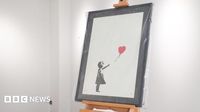For more than a year, James Love lived under the shadow of a serious accusation: that he was an accomplice in the daring theft of a Banksy artwork from a central London gallery. But on Friday, 19 September 2025, a jury at Kingston Crown Court found the 54-year-old builder from North Stifford, Essex, not guilty of burglary, bringing an end to a case that had gripped both the art world and the local community.
The story began in the early hours of 8 September 2024, when Larry Fraser, 48, smashed the glass front door of the Grove Gallery on New Cavendish Street, Fitzrovia. Within a rapid 36 seconds, Fraser snatched a limited-edition print from the celebrated street artist Banksy’s ‘Girl with Balloon’ series. The artwork, valued at £270,000, was the only item stolen during the raid, but its loss resonated far beyond the gallery’s walls. According to BBC News, the print had been part of an exhibition showcasing a £1.5 million collection of 13 Banksy pieces, underscoring the magnitude of the theft.
James Love’s alleged involvement stemmed from his long-standing acquaintance with Fraser. The two men had known each other for about 20 years, with Love occasionally hiring Fraser for laboring jobs. On the day of the burglary, Love drove to the gallery, was in regular contact with Fraser, and helped stash the stolen print afterward. CCTV footage presented in court showed Love assisting Fraser into a van with the artwork. These facts, as reported by Thurrock Nub News and BBC News, painted a damning picture—at least at first glance.
The prosecution argued that Love had acted as the getaway driver in a premeditated theft, conspiring with Fraser to steal one of the nation’s most beloved pieces of modern art. The defense, however, told a different story. Love testified that he was unaware of Fraser’s intentions until the moment he saw the stolen print. "This was the first time I realized what Fraser had done," Love told the jury, insisting that he was furious upon discovering the truth. He described feeling used by Fraser, a sentiment that would ultimately resonate with the jurors.
After the theft, Love played a pivotal role in the recovery of the artwork. He left the Banksy print at a block of flats in the Isle of Dogs, then provided police with a map and detailed instructions at his first court appearance. Thanks to this information, authorities were able to recover the piece and return it to the Grove Gallery. This cooperation, noted by both Thurrock Nub News and BBC News, weighed heavily in Love’s favor.
The trial itself was marked by a mix of forensic evidence, CCTV footage, and personal testimony. Jurors heard how Love’s actions on the morning of the burglary—driving to the gallery, maintaining contact with Fraser, and helping to stash the print—could be interpreted as complicity. But Love’s account of events, coupled with his assistance in recovering the artwork, introduced significant doubt. The jury ultimately found that the prosecution had not proven beyond reasonable doubt that Love was a willing participant in the crime.
Fraser, on the other hand, admitted his guilt early on. Captured on camera smashing his way into the gallery and making off with the artwork, Fraser pleaded guilty to burglary ahead of Love’s trial. He is scheduled to appear at Kingston Crown Court on Thursday, 25 September 2025, when a date for his sentencing is expected to be fixed, as reported by BBC News.
The Banksy print at the center of the case, ‘Girl with Balloon,’ is no ordinary artwork. Part of a series of paintings and stencils by the elusive guerrilla artist, the image of a young girl reaching for a heart-shaped balloon has become iconic, voted the nation’s favorite artwork in 2017. Its theft sent shockwaves through the art community, not only for its monetary value but for its cultural significance. The Grove Gallery’s exhibition, featuring 13 Banksy pieces valued at £1.5 million, was a major event for London’s art scene, making the loss—and subsequent recovery—of ‘Girl with Balloon’ all the more dramatic.
For Love, the ordeal has been life-altering. As a builder with no prior convictions, the accusation came as a shock. The year-long wait for his case to be heard was, by all accounts, a period of great personal strain. During his testimony, Love recounted his relationship with Fraser, explaining how their professional association had led to a situation he never anticipated. The jury’s verdict brought relief, but also a measure of reflection on how quickly one’s life can be upended by association.
The case also highlighted the challenges faced by law enforcement and the courts in untangling the complexities of art theft. High-profile works like those of Banksy are both coveted and vulnerable, and the rapid, targeted nature of the Grove Gallery raid underscored the need for robust security measures. Yet, as this case demonstrated, the human stories behind such crimes are rarely straightforward.
As for the artwork itself, its recovery was met with celebration. The print was returned to the Grove Gallery, allowing the public once again to appreciate a piece that had briefly disappeared into the shadows. The incident served as a reminder of the enduring allure of Banksy’s art—and the lengths to which some will go to possess it.
In the aftermath, questions linger about the broader implications for those who find themselves inadvertently caught up in criminal acts. Love’s case, with its blend of suspicion, exoneration, and cooperation, offers a cautionary tale. It also brings into focus the importance of due process, the presumption of innocence, and the power of a fair trial to right a potential wrong.
With Fraser’s sentencing still pending and the art world breathing a sigh of relief, the saga of the stolen ‘Girl with Balloon’ has come full circle. For James Love, the verdict marks the end of a harrowing chapter—and, perhaps, the start of a quieter, more hopeful future.
